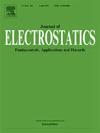导电液滴在直流和脉冲电压下电聚结过程的异同
IF 1.9
4区 工程技术
Q3 ENGINEERING, ELECTRICAL & ELECTRONIC
引用次数: 0
摘要
本文研究了脉冲直流电压下的电聚结过程。本研究旨在为电压频率对电聚结的影响提供物理解释,并将其与恒定直流电压进行比较,以识别差异并评估脉冲直流电压在静电脱水中的潜在优势。采用基于任意拉格朗日-欧拉方法的数值模型模拟了电聚结过程。该模型解释了由介电色散介质(油)和导电分散相(水)组成的两相系统的行为。结果表明,无论是在液滴振荡特征频率以上的高频范围内,还是在极低频范围内,电聚结过程都与恒定直流电压下相似。然而,在接近特征频率的频率范围内,观察到从聚结到非聚结过渡的阈值略有增加,这是由于液滴之间形成电桥后暂时没有电压。然而,这个阈值的增加被限制在大约5%,并且仍然是概率性的,因为它取决于接触时刻电压信号的相位。此外,在特征频率下,聚结导致形成较小的液滴而不是较大的液滴,从而对清洗过程的整体效率产生负面影响。本文章由计算机程序翻译,如有差异,请以英文原文为准。
Similarities and differences in electrocoalescence processes of conducting uncharged droplets at the DC and pulsed voltage
This article investigates the electrical coalescence processes under pulsed DC voltage. The study aims to provide a physical explanation for the effect of voltage frequency on electrocoalescence and to compare it with constant DC voltage to identify differences and assess the potential advantages of pulsed DC voltage in electrostatic dehydration. A numerical model based on the arbitrary Lagrangian–Eulerian method is employed to simulate the electrocoalescence process. The model accounts for the behavior of a two-phase system consisting of a dielectric dispersion medium (oil) and a conductive dispersed phase (water). The results indicate that, in both the high-frequency range above the characteristic frequency of droplet oscillations and the extremely low-frequency range, the electrocoalescence process behaves similarly to the case with constant DC voltage. However, in the frequency range near the characteristic frequency, a slight increase in the threshold for the transition from coalescence to non-coalescence is observed, due to the temporary absence of voltage following the formation of a bridge between droplets. Nevertheless, this threshold increase is limited to approximately 5 % and remains probabilistic, as it depends on the phase of the voltage signal at the moment of contact. Additionally, at the characteristic frequency, coalescence results in the formation of smaller droplets rather than larger ones, negatively impacting the overall efficiency of the cleaning process.
求助全文
通过发布文献求助,成功后即可免费获取论文全文。
去求助
来源期刊

Journal of Electrostatics
工程技术-工程:电子与电气
CiteScore
4.00
自引率
11.10%
发文量
81
审稿时长
49 days
期刊介绍:
The Journal of Electrostatics is the leading forum for publishing research findings that advance knowledge in the field of electrostatics. We invite submissions in the following areas:
Electrostatic charge separation processes.
Electrostatic manipulation of particles, droplets, and biological cells.
Electrostatically driven or controlled fluid flow.
Electrostatics in the gas phase.
 求助内容:
求助内容: 应助结果提醒方式:
应助结果提醒方式:


